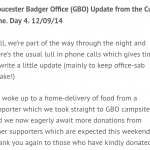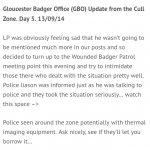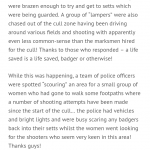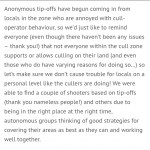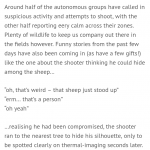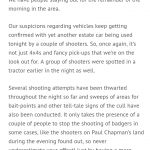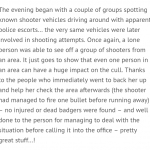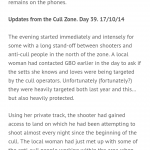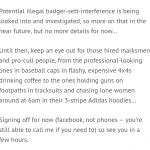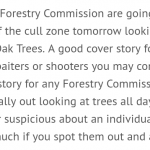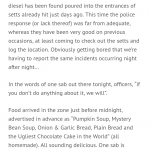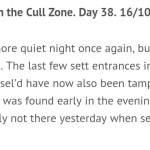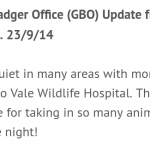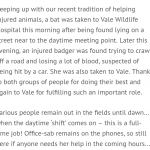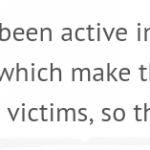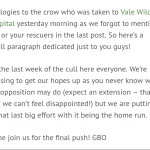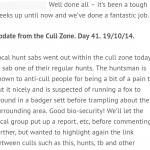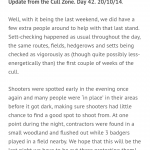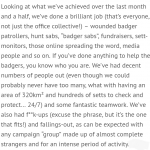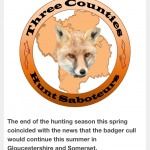 ‘Year 2’ held a number of changes for us – Three Counties Sabs had been out monitoring local hunts and intervening when necessary since the end of the 2013 cull and had just returned from one of the last hunt meets of the season when they heard that the cull was to go ahead again for another year. Yes, despite the screw-ups with figures, the fact that roadkill badgers had been included in the figures, that shooting had not been deemed humane and certainly could not (sensibly) be called a success (although of course, they did label it as such) it was going ahead once more. Preparations were immediately underway…
‘Year 2’ held a number of changes for us – Three Counties Sabs had been out monitoring local hunts and intervening when necessary since the end of the 2013 cull and had just returned from one of the last hunt meets of the season when they heard that the cull was to go ahead again for another year. Yes, despite the screw-ups with figures, the fact that roadkill badgers had been included in the figures, that shooting had not been deemed humane and certainly could not (sensibly) be called a success (although of course, they did label it as such) it was going ahead once more. Preparations were immediately underway…
 First, get sett-surveying more thoroughly in the zone and gather up-to-date info on the area…
First, get sett-surveying more thoroughly in the zone and gather up-to-date info on the area…
Second, create a more solid collective and share responsibilities out more…
With a fellow campaigner setting up a facebook page and others sorting out an email address and finalising a phone number, we also brought on board a couple of people who were part of ‘United Active Badger Army’ on facebook. They took on roles of fundraising and ‘welfare’ as well as working on setting up camp proper! A couple of people who had worked hard throughout year one took on some independent fundraising for the cull zone, raising some much-needed money, while putting together local information for those coming into the zone. Various people were added as admins to the facebook page.
Gloucestershire Badger Office grew organically into a collective!
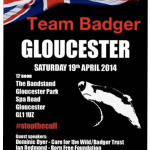 We were out in the fields and online trying to raise awareness and get more info out there through skill shares and workshops, ‘introduction to the cull zone’ and sett-surveying days plus daily surveying tips and articles posted on the page. Someone was working on mainstream media alongside this with others focusing on gathering Intel. A march was planned in Gloucester which is a city just south of the A40, the southern-most boundary of the cull zone. It was well-attended and we met a lot of new people as well as meeting some from the previous year (it can be difficult at first to recognise people in daylight when you’ve only seen them in the early hours of the morning out on dark tracks and footpaths!)
We were out in the fields and online trying to raise awareness and get more info out there through skill shares and workshops, ‘introduction to the cull zone’ and sett-surveying days plus daily surveying tips and articles posted on the page. Someone was working on mainstream media alongside this with others focusing on gathering Intel. A march was planned in Gloucester which is a city just south of the A40, the southern-most boundary of the cull zone. It was well-attended and we met a lot of new people as well as meeting some from the previous year (it can be difficult at first to recognise people in daylight when you’ve only seen them in the early hours of the morning out on dark tracks and footpaths!)
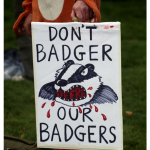 One of the collective was extremely happy when a guy came up to her and said he’d been vegan since he met her the previous year (she had responded to a call for back-up and, later, they had had a chat about how she’d got involved in animal liberation campaigns).
One of the collective was extremely happy when a guy came up to her and said he’d been vegan since he met her the previous year (she had responded to a call for back-up and, later, they had had a chat about how she’d got involved in animal liberation campaigns).
Meanwhile, our police liaison had fully taken on the role and was spending the months between the culls holding Gloucestershire and West Mercia police forces to account for any bad behaviour from the previous year while coming up with strategies to deal with future culls in a hopefully less-biased way. We began to attend multi-agency group (MAG) meetings which were often quite interesting… such as when Simon from the NFU referred to us as terrorists! It wasn’t perfect but it was a much different atmosphere to that of the previous year! Police were not being brought in from all over the country and they were beginning to come up with better strategies to deal with the mess of the cull. Like we said, it wasn’t perfect…
“I remember being pulled over one night because the police thought that it was weird that I was driving in Gloucestershire when I lived in Worcestershire”, says one campaigner who lives not far from the Gloucestershire border.
Due to potential issues regarding phone signal, the general feeling was that someone should run the phone lines from a landbase during the cull. This meant that more work could be done online and more research done than what could be done from the field… but it took a sab out of action. She tried, however, to keep the spirits up of those out in the fields while updating (and hopefully enticing in) others through regular updates online and text-outs throughout the nights to keep everyone up-to-date and connected. And, with the land-base being close to the ‘East Side’ of the cull zone, she was out during the day on several occasions sett-checking and responding to calls for advice, help with injured wildlife and back-up (as well as attending hunt meets in the area as hunts started ‘cub-hunting’ around the same date as the cull began).
We were still learning but with more people becoming involved and making more suggestions the campaign was growing nicely.
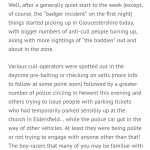 The cull had lasted about 12 weeks the previous year, the police being heavy-handed and the numbers of police officers and cull contractors overwhelming at times. We wouldn’t know what to expect until it all started again.
The cull had lasted about 12 weeks the previous year, the police being heavy-handed and the numbers of police officers and cull contractors overwhelming at times. We wouldn’t know what to expect until it all started again.
What we did know was that there were no longer going to be independent monitors and that guidelines on conducting the cull were being relaxed.
The first day was so quiet that it was difficult to tell if the cull had actually started – we were keeping an eye on a couple of cages which had been found tied open (to allow badgers time to get used to them) and these were now set, ready to trap any badger that entered. Only legal to do so once the cull had begun. Suddenly we got a call from Nottingham Hunt Sabs – shooters had turned up to a cage with a badger in it and, compromised, they would have to release him. Upon police arrival they (reluctantly) did so. The cull was certainly on.
The following few weeks were very ‘up and down’ in terms of how busy the cull-zone itself actually was… although few people managed to get any decent sleep throughout and there always seemed to be something to do!
We expected there to be fewer cull contractors coming into the area and for it to become more of a locally-led cull but, still, we expected it to be somewhat more chaotic than it was. We were very busy, don’t get us wrong(!) but with fewer police on the ground, more honed intel-gathering and connections with various locals on the ground we worked more efficiently. There was the usual silliness from hunters…
The ‘Three Counties Sabs’ area of the zone had started to organically split into different areas with groups forming up to survey and subsequently protect those areas. Cirencester Illegal Hunt Watch and North Wales Hunt Sabs, as examples, took on responsibility for an area each. Three Counties specifically organised two areas while a 3C sab ran the phones and kept a general overview over the whole Glos zone. Other areas were protected by new groups of locals and campaigners from further afield or individuals keeping an eye on nearby setts whilst walking their dogs, for example.
 With so much going on we started to meet with people at a third daily meeting point… at 2am. This was so that we could ensure that there would be some people out and about in the early hours of the morning – up until that point we had prioritised daytime checks due to cages and bait points and the first part of the evening and night when badgers would be emerging from their setts. As more people wanted to get involved we made sure that we could have more people out, a ‘skeleton crew’ during the early hours as many would have to leave by around 2am due to work / family commitments. Despite lower numbers of people at these times, we still managed to keep an eye on many areas across the zone and shooters continued to be thwarted (as well as people on the ground catching contractors putting out badger traps).
With so much going on we started to meet with people at a third daily meeting point… at 2am. This was so that we could ensure that there would be some people out and about in the early hours of the morning – up until that point we had prioritised daytime checks due to cages and bait points and the first part of the evening and night when badgers would be emerging from their setts. As more people wanted to get involved we made sure that we could have more people out, a ‘skeleton crew’ during the early hours as many would have to leave by around 2am due to work / family commitments. Despite lower numbers of people at these times, we still managed to keep an eye on many areas across the zone and shooters continued to be thwarted (as well as people on the ground catching contractors putting out badger traps).
It wasn’t just badgers that we tried to protect, once again, and Vale Wildlife Hospital did a fantastic job of treating animals brought in:
With more people out in the zone, and with a public phone number that anyone could ring in on, far more injured animals were being spotted and taken for treatment.
And it wasn’t just cull contractors that we had to deal with as a huge number of lampers and poachers were also caught (we even ended up assisting landowners and police on a couple of occasions chasing poachers down who had been trespassing and shooting on the land! Various others were caught in different areas, including these guys…
As the cull came to an end we began working on new projects including trying to raise more local awareness and find ways for more people to get involved. Three Counties Sabs, for example, began trying to raise more awareness, amongst farmers as well as other locals and anti-cull activists, about potential links between the activities of hunts and the spread of TB…
It had been a long old slog again, despite not having an extension to deal with this year, but we knew we’d fought the cull hard again and we awaited the release of the figures. Any badger killed is one too many… but keeping the figures low was the best we could do. And, once again, the cull contractors FAILED to reach even the minimum target of 675 badgers, instead managing to kill 274. In Somerset the target was reached, but then they had set it so low (316) that it wasn’t a difficult feat (they managed to kill 341).

